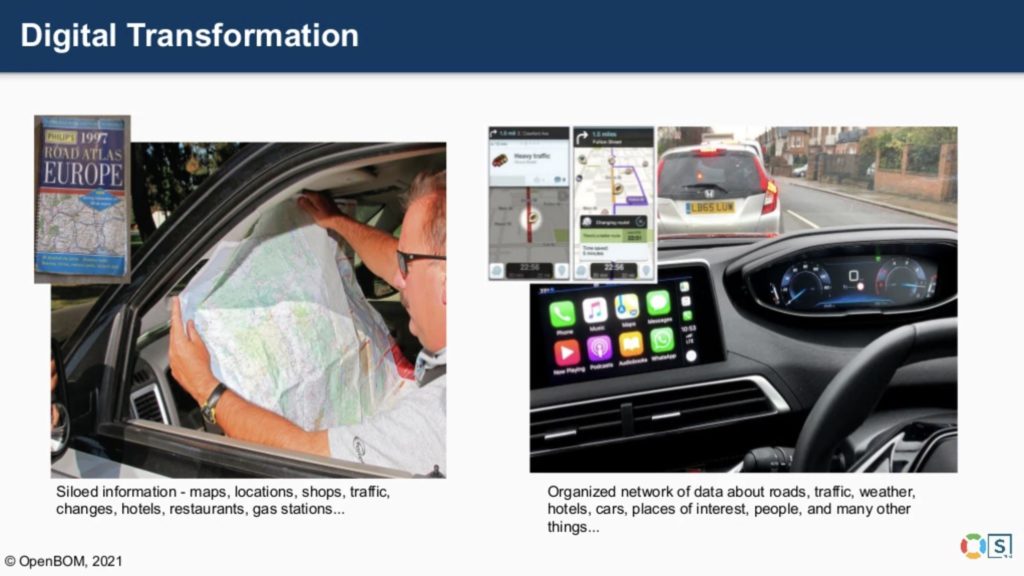
The weekend is a good time to catch up on multiple publications and social posts. There are a few that caught my attention last week. The first was CIMdata PLM Road Map & PDT Fall 2021 conference, which was completely virtual this time. Jos Voskuil of Virtual Dutchman provided a comprehensive review of the event in his The weekend after… article. Check it out here. Another conference material to catch up on was the NextBLD conference, which happened last week in London. The event was physical, but the materials from the event are available online for streaming. Register using this link – it is free. There is one trend, which I found common between these two events. Although the events belong to two different industries (PDT was mostly about manufacturing and NextBLD was mostly about construction), both industry trajectories are moving towards creating connected environments. Which made me think about Connected PLM Transformation as a trend.
The history of Product Lifecycle Management was very much related to data control and how to ensure that data created using business systems during the engineering stage of product development by PLM software was correctly delivered to the manufacturing process. PLM software was very much focused on document management – CAD systems produced documents that very delivered from engineering to manufacturing. Actually, the entire product lifecycle was very much document-driven. The product development process was documented and released docs were sent between people and departments of the organization.
The next trend in PLM system development will be more focused on the product lifecycle and not documents. To make it happen a solution solutions will have to transform from document handover to something different. This new process and environment will redefine the entire product lifecycle and businesses process. The main shift will be the move from documents to data. This is a very simple switch, but it will be very hard to do for all organizations because such fundamental changes are usually very hard.
The Paradigm Shift
The core of the process is a transformation of the industry from one paradigm to another. Check the materials from the event Demystify Modern PLM organized by OpenBOM and Share PLM. I want to point you to one picture that will give you an idea of the transformation. Check the product session and specifically pay attention to this picture

The main point is related to the way the information to manage the driving process was managed. Think about old fashion “Maps” that were mostly documents presented in a variety of forms from books, paper copies, later computer files stored on CDs and loaded into early navigation devices. The software solutions for this GPS (navigation) were focused on how to display the image and less on the driving process management.
What happened over time is that solution was focused on how to use up-to-date information to improve the driving process, which created a greater business value for the drivers. Starting from the updated maps, later on, moved how to present a variety of data pieces (eg. traffic, business information, driving options, information about accidents, police cars, road conditions, and many others). You can think about the entire digital thread of the information connected together using a modern smartphone or integrated media unit in the car. The experience is different, which relied completely on a new information model. However, the fundamental element of this movement was a shift from the “document” model (aka Maps) to the “data” model (an online data set with the information that can be collected granularly and presented to the driver in a contextual and later augment way).
What does it mean for PLM (product lifecycle management) business strategy, technology and software? Here are 3 fundamental steps in modern PLM software development that will lead towards this connected PLM transformation.
Product Data
Manufacturing companies are sitting on a massive amount of the data that represents the business processes of the entire lifecycle. But the data created by CAD (computer-aided design) systems and many other solutions are super fragmented, stored in CAD files, Excels, multiple databases, legacy solutions. The data stored in the design phase where the digital thread begins is not connected to the downstream processes. The engineering design is not connected to the downstream manufacturing and to the extended enterprise. The product structure created during the earliest stages of the product’s lifecycle is not connected to the real world of the actual processes. The data from engineers is very CAD-centric and not connected to customers and to actual physical products.
The transformation of product data will lead to the creation of a data-centric environment, global standards of data representation, and granular pieces of information that can be used instead of old fashion CAD drawings and 3D CAD models saved in the files.
Online Services
Current product lifecycle paradigms are very much focused on how to release documents and move them between stages. This is was the goal of product data management software focused on data control. Such PLM solutions were efficient 10-20 years ago but cannot serve modern global organizations. These days companies are looking at how to use technologies to provide information in real-time. The data is needed right now and right here and nobody is actually focusing on how to find the document. Real-time data is the key and therefore a new technological mechanism is needed to provide solutions to solve modern engineering challenges developing complex products, accelerating time, connecting supply chains, shortening time to market, and optimizing product cost.
Online services are the software answer to solve the problem. Technology for the systems using online services is available and used in a variety of different market applications. New PLM environments and tools will be adopting online services and by doing so will provide a new service-oriented PLM environment.
Digital Thread and Data Sharing
A combination of granular data and connected services will create a foundation for a new type of PLM software. YOu can think about it as one platform, which connects multiple services and provides resources for manufacturing companies, their partners, contractors, and suppliers. The technology for such a system is already available. The system will help organize a complex digital thread of information, improve product quality of product development, integrate data, accelerate new product launch, connect the supply chain, and will replace the old fashion product data management (PDM) systems mostly focusing on document management. This process is not simple and will take time. The starting elements of this process can be already seen by creating digital twin models, vendors moving to SaaS and cloud applications, and many other steps.
What is my conclusion?
Connected PLM transformation is a process that will touch an entire PLM industry and will change the product lifecycle management as we know it now. PLM software will move from a business system mostly focusing on engineering and managing documents into an online service focusing on innovation, helping to manage holistic data about the products from design to manufacturing, compliance, maintenance, and an entire lifecycle of the product. It is a multi-phased process of the system and data transformation that will redefine PLM bottom-up. Just my thoughts…
Best, Oleg
Disclaimer: I’m co-founder and CEO of OpenBOM developing a digital network-based platform that manages product data and connects manufacturers, construction companies, and their supply chain networks. My opinion can be unintentionally biased.
The post Connected PLM Transformation appeared first on Beyond PLM (Product Lifecycle Management) Blog.



Be the first to post a comment.